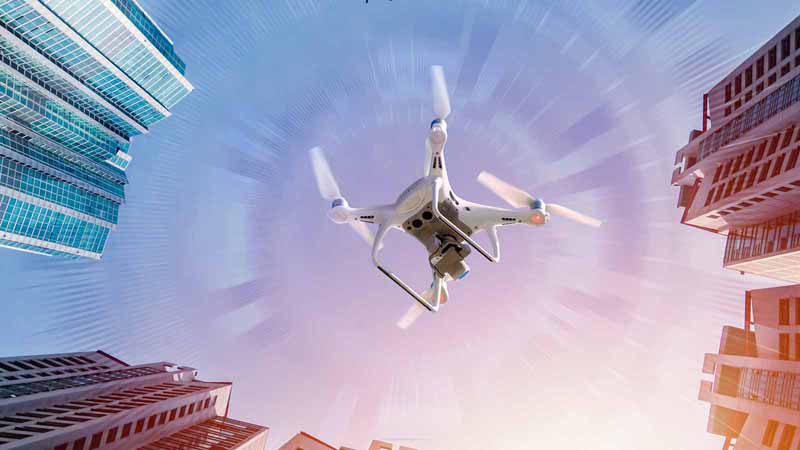Advances in Drone Technology and What’s Next
By
Yisela Alvarez Trentini
|
Saturday, 14 November 2020
|
Tech
According to a market report, the global drone market is expected to grow from $22 billion in 2020 to $42.8 billion in 2025, driven by an acceleration in developments from China, Japan, and India. Drone deliveries could take a central role, alongside enthusiasts that could help sales reach $12 billion in 2021.

Drones are becoming increasingly popular. Over the past few years, these miniature pilotless aircraft have become indispensable for various businesses and government organizations due to their ability to increase efficiency and decrease workloads and production costs.
Because drones can be controlled by a remote or a smartphone app, they can reach remote areas easily. For example, throughout the COVID-19 pandemic, drones have been used to deliver groceries and medicines in several programs across the nation and the globe, illustrating the possibilities and potential for this technology.
The Drone Market Report 2020-2025 forecasts that “the global drone market will grow from $22.5 billion in 2020 to over $42.8 billion in 2025 at a CAGR of 13.8%,” with the Asian market replacing North America’s market as the world’s largest. This is great news for military, commercial, and civilian drone users.
Military Drone Technology
Drones have existed for over two decades but have only seen significant adoption and usage in the last years. One of the primary uses has been in the military—with drones being utilized as target decoys and for supervision, research, and combat missions. The military works with drones of all sizes—from small and stealthy quadcopters just a few inches in width to 131 feet jet-sized aircraft.
According to a Goldman Sachs report, the military will continue to invest in drone technology in the years to come. It is estimated that $70 billion will be spent on drones to replace human pilots in 2020. A single US Predator uncrewed aircraft, capable of executing high-profile and time-sensitive missions, has a cost of nearly $4 million—which brings the US Predator program alone to about $2.4 billion.
Commercial and Civil Applications
The utility of drones goes, however, well beyond the military. These flying mini-robots can assist with express shipping and delivery, photography, search and rescue, geographic mapping, and precision crop monitoring, among many others. In terms of endurance, range, safety, and cost-efficiency, drones have surpassed crewed aircraft.
The commercial use of drones is definitely gaining momentum. Although the industry is still young, drones are becoming powerful business tools with applications across several industries and segments. According to Goldman Sachs, the biggest job opportunities for drones are in construction, agriculture, insurance claims, offshore oil and gas, police, fire, coast guard, and journalism.
Today, an estimated 20,000 delivery drones are being used for different purposes, some of which include shipping medical supplies and basic groceries. According to a Gartner report, the rise in these numbers could reach up to 1 million by 2026. Last September, for example, American delivery company Zipline announced a partnership with Walmart to offer on-demand drone deliveries of health products. This year, Amazon has also received approval from the Federal Aviation Administration to operate nationally as a drone airline. The company had services planned for 2020 but had to postpone them due to the pandemic.
Popular Drones
Drones have become particularly on-trend for aerial filmmakers and photographers. Business Insider Intelligence expects sales of civilian drones to reach $12 billion in 2021. The last years have seen great improvements in battery life, connectivity, and image stabilization and quality that make drones an affordable hobby for all. Even the smaller models are able to film in 4K. However, tech-savvy fans may be interested in other options such as quadcopters that come with multiple camera arrays, GPS, and first-person control.
PCMag has declared the DJI Mavic Air 2 Pro the “best small drone on the market.” Mavic drones are small, foldable, and can be easily transportable. With a price of about $1,729, these drones have the largest image sensor in the market and are used by enthusiasts pilots all around the world. Other drones with excellent reviews include the Autel Robotics EVO, priced at $1,049 and equipped with a powerful camera on a 3-axis stabilized gimbal, and the Parrot ANAFI, a super-compact 4K HDR drone that costs about $700.
Regulation
Countries worldwide are working on regulations to make sure drones don’t invade people’s safety and privacy.
In the US, the Federal Aviation Administration (FAA) has recently published a new amendment to the US Drone Law 2020. A license is required to fly recreational drones in uncontrolled airspace. No authorization is needed, but drones need to be registered, and users can only fly below 400 feet. If a drone is under 250 grams in weight (like the tiny 249g DJI Mavic Mini), no registration is required.
The Next Generation of Drones
The next generation of drones is expected to make uncrewed flights even more efficient, improving on range, stealth, autonomy, and payload capacity. Sophisticated drones could take over various everyday tasks currently handled by humans, such as fertilizing crops, monitoring traffic accidents, and delivering products.
According to Amazon services affiliate Air Drone Craze, drone technology is now in generation 5 out of 7. Generation 5 includes 360° gimbals, 4K video, and intelligent piloting modes. Generation 6 will bring designs based on safety and regulatory standards, payload adaptability, and full autonomy. Generation 7, the most advanced, should see the rise of fully compliant drones with enhanced piloting systems, full airspace awareness, and auto action.
A lot of these advances are already underway. For example, 3DRobotics recently announced its “Solo” drone, a smart model with compliance tech that could become the next big revolution in transport, commercial, military, and logistics.
“Solo” drone, a smart model with compliance tech, could become the “next big thing” in the military while addressing emerging, innovative business needs.
About the Author
Yisela Alvarez Trentini is an Anthropologist + User Experience / Human-Computer Interaction Designer with an interest in emerging technologies, social robotics, and VR/AR.

